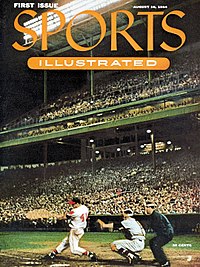Sports Illustrated magazine

The first issue of Sports Illustrated, showing Milwaukee Braves star Eddie Mathews at bat and New York Giants catcher Wes Westrum in Milwaukee County Stadium
|
|
| Editorial Director, Time Inc. Sports Group | Chris Stone |
|---|---|
| Staff writers |
Staff
Managing Editor SI.com: Stephen Cannella 'Senior Writers: Kelli Anderson, Lars Anderson, Chris Ballard, Michael Bamberger, George Dohrmann, David Epstein, Michael Farber, Damon Hack, Lee Jenkins, Peter King, Thomas Lake, Tim Layden, J. Austin Murphy, Dan Patrick, Joe Posnanski, S.L. Price, Selena Roberts, Alan Shipnuck, Phil Taylor, Ian Thomsen, Jim Trotter, Gary Van Sickle, Tom Verducci, Grant Wahl, L. Jon Wertheim Associate Editors: Darcie Baum (Swimsuit); Mark Beech, Adam Duerson, Gene Menez, Elizabeth Newman, David Sabino (Statistics) Staff Writers: Brian Cazeneuve, Albert Chen, Chris Mannix, Ben Reiter, Melissa Segura Deputy Chief of Reporters: Lawrence Mondi Writer-Reporters: Sarah Kwak, Andrew Lawrence, Rick Lipsey, Julia Morrill, Rebecca Sun, Pablo S. Torre Reporters: Kelvin C. Bias, Matt Gagne, Rebecca Shore |
| Categories | Sports magazine |
| Frequency | Weekly |
| Publisher | Brendan Ripp |
| Total circulation (December 2015) |
3,023,197 |
| First issue | August 16, 1954 |
| Company | Time Inc. |
| Country | United States |
| Based in | New York, USA |
| Language | English |
| Website | www.SI.com |
| ISSN | 0038-822X |
Managing Editor SI.com: Stephen Cannella
Managing Editor SI Golf Group: Jim Gorant
Creative Director: Christopher Hercik
Director of Photography: Brad Smith
Senior Editor, Chief of Reporters: Richard Demak
Senior Editors: Mark Bechtel, Trisha Lucey Blackmar, MJ Day (Swimsuit); Mark Godich; Stefanie Kaufman (Operations); Kostya P.
Sports Illustrated is an American sports media franchise owned by Time Inc. Its self-titled magazine has over 3 million subscribers and is read by 23 million people each week, including over 18 million men. It was the first magazine with circulation over one million to win the National Magazine Award for General Excellence twice. Its swimsuit issue, which has been published since 1964, is now an annual publishing event that generates its own television shows, videos and calendars.
There were two magazines named Sports Illustrated before the current magazine began on August 16, 1954. In 1936, Stuart Scheftel created Sports Illustrated with a target market for the sportsman. He published the magazine from 1936 to 1938 on a monthly basis. The magazine was a life magazine size and focused on golf, tennis, and skiing with articles on the major sports. He then sold the name to Dell Publications, which released Sports Illustrated in 1949 and this version lasted 6 issues before closing. Dell's version focused on major sports (baseball, basketball, boxing) and competed on magazine racks against Sport and other monthly sports magazines. During the 1940s these magazines were monthly and they did not cover the current events because of the production schedules. There was no large-base, general, weekly sports magazine with a national following on actual active events. It was then that Time patriarch Henry Luce began considering whether his company should attempt to fill that gap. At the time, many believed sports was beneath the attention of serious journalism and did not think sports news could fill a weekly magazine, especially during the winter. A number of advisers to Luce, including Life magazine's Ernest Havemann, tried to kill the idea, but Luce, who was not a sports fan, decided the time was right.
The goal of the new magazine was to be basically a magazine, but with sports. Many at Time-Life scoffed at Luce's idea; in his Pulitzer Prize–winning biography, Luce and His Empire, W. A. Swanberg wrote that the company's intellectuals dubbed the proposed magazine "Muscle", "Jockstrap", and "Sweat Socks". Launched on August 16, 1954, it was not profitable (and would not be so for 12 years) and not particularly well run at first, but Luce's timing was good. The popularity of spectator sports in the United States was about to explode, and that popularity came to be driven largely by three things: economic prosperity, television, and Sports Illustrated.
...
Wikipedia
